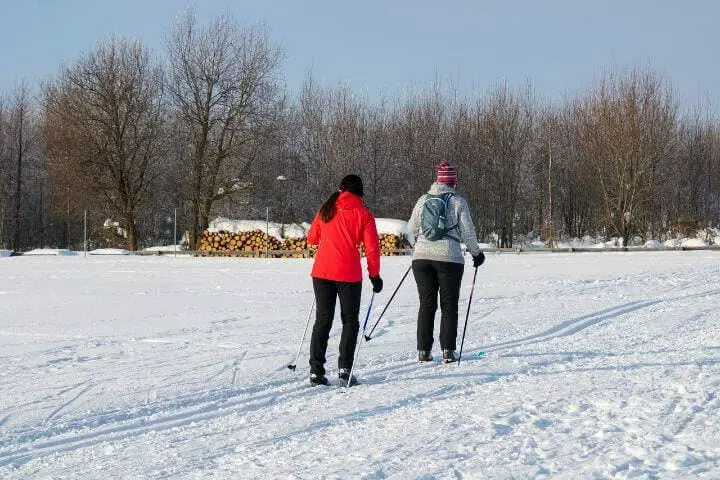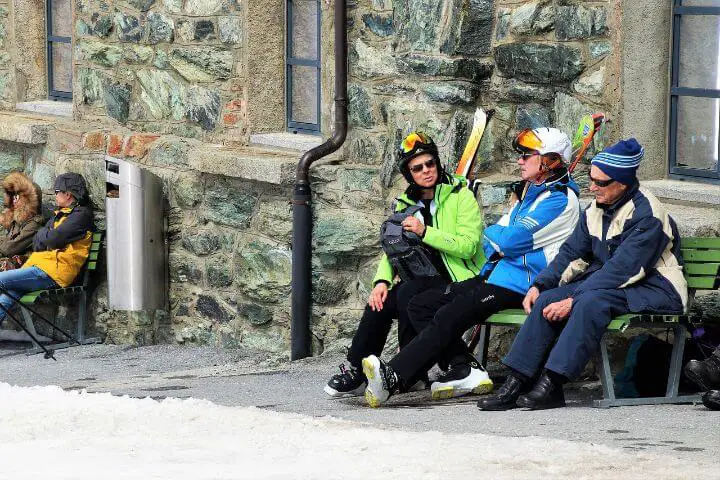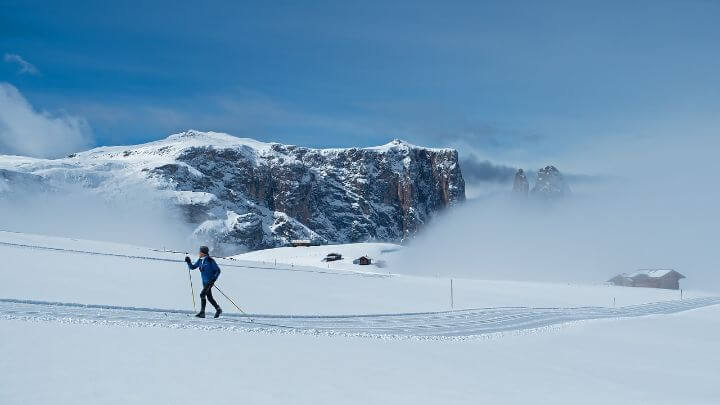Staying active for as long as we can will add so much extra enjoyment to our lives, and it can really help with avoiding injury and illness – especially as we age.
As you age, there are certain activities we might feel like we can’t (or shouldn’t) do anymore but there are definitely ways everyone can continue to enjoy the activities they love no matter how old they are.
Skiing is a great way to be able to get outdoors when winter comes around so that you can stay active – even if it’s below freezing outside. Skiing can be seen as an activity that is high impact and really for those who are younger and very fit, but skiing can be enjoyed by everyone.
Whether you have been skiing for years or just want to take up a hobby, skiing can be enjoyed by seniors of almost all abilities to some degree.
Contents
Different Types of Skiing
There are a few different kinds of skiing, so you don’t have to worry about blazing down a hill if you don’t want to.
Downhill Skiing
This kind of skiing is usually what comes to mind when someone mentions skiing, which is fair because it’s likely the most popular. This kind of skiing may also be known as alpine skiing.
This kind of skiing usually takes place at some kind of resort or on a mountain, and involves using a ski lift to get to the top so that you can ski down. There are several different levels of skill in downhill skiing, and most hills will be labeled to indicate the level of skill needed.
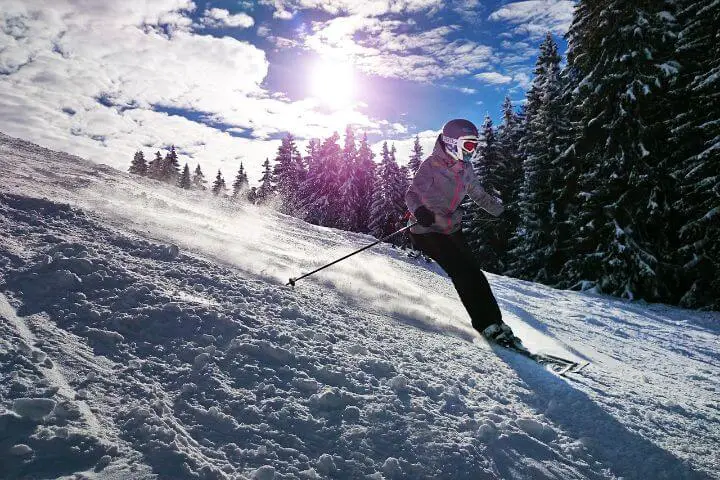
The skills will usually be listed from bunny slopes (or beginning hills) all the way to black diamond hills. If you don’t feel totally comfortable with the hill, it’s ok to move down a level and just enjoy the time spent skiing.
There are a few disciplines that fall into downhill skiing, based on technique used or how a skier goes down the hill. Downhill skiing encompasses a large number of sub-categories of skiing.
Cross Country Skiing
This kind of skiing can be done on designated trails or in the backcountry, but the overall terrain is flat or has small, gentle hills instead of being done on a steep, downward slope like downhill skiing.
Cross country skiing focuses on skiers going long distances instead of going down one hill and back up on a ski lift. The equipment used in cross country skiing is slightly different from downhill skiing.
For example, the skis themselves are longer and skinnier than what would be used for downhill. On top of that, the bindings are slightly different in that they clip the toe of the boot to the ski but leave the heel free to move up and down which helps the skier to move forward.
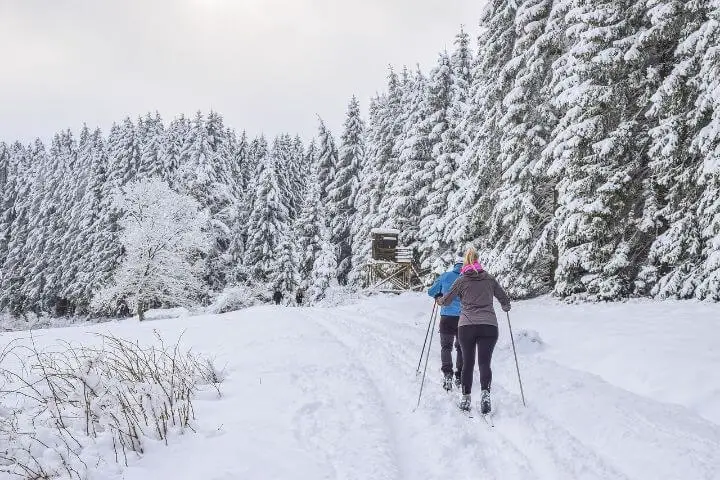
Cross country skiing has two categories: classic and skate skiing. The classic is where skiers keep their skis parallel to each other and move forward by kicking and gliding back and forth.
The skat skiing, however, is exactly as it sounds: skating on skis. This style of skiing uses shorter skis and athletes will propel themselves forward by kicking out the side in the same way you would when skating.
Adaptive Skiing
This isn’t a distinct skiing discipline on its own, but rather there are aids that can be used to make skiing accessible to someone with a disability. This allows everyone to enjoy skiing in some way but within their range of abilities. Almost any kind of skiing can be adapted to make it work for almost any disability.
You might also like Best Rehab Bikes for Wheelchair Users
Skiing Tips for Seniors
Whether you’ve never tried skiing and just want to do something different, or you’ve been skiing for years and just want to keep active as you age there are a few easy tips to follow to make skiing enjoyable.
Don’t Overdo It
In other words: less is more. You don’t have to be the fastest down the hill or finish the cross country skiing course first – this is the time for you to enjoy yourself and take in the surroundings.
If you are on a mountain and skiing downhill, imagine the view you will get from the top and as you descend down the hill. Even though you are likely very proud of your physical condition to be skiing as a senior, this isn’t the time to overdo it though and just enjoy your time.
At this point in your life, your legs will likely tire quicker and your reaction time might be slower – especially if there are obstacles on a downhill ski course.
Check Your Equipment
You should always use safe equipment, but especially now when your reflexes might be slower and you might get tired quicker.

This could include adding a ski brake to your skis – which is basically a strap around the skis to prevent one of them from sliding away. Before heading out the slopes, just do a quick check to make sure your equipment is functioning as it should and it’s safe to use.
Choose off-Peak Times
If you’re skiing in your senior years, chances are you’re also retired from your career. The benefit to this is that you can choose to go skiing at times when other people are probably working.
By doing this, you can avoid the slopes from being busy or long line ups with skiers who might be trying to move the pace faster than you might want to. Choosing less busy times will allow you to fully enjoy the experience instead of worrying about those around you.
Wear a Helmet
Many skiers you see out there will not wear a helmet when skiing, but that doesn’t mean you shouldn’t do this.
Helmets are becoming much more popular – especially amongst first time skiers. Helmets come in a wide range of colours and styles, so you’re definitely likely to find something that suits you.
A helmet will keep your brain safe in case of an accident, but it will also help keep your ears safe from the wind of going downhill and keep them warm while it’s freezing.
Make Sure to Bring Your Cell Phone
This tip is kind of two-fold: safety and memories. If you get lost or someone gets hurts while cross country skiing, having a cell phone means you can call for help. On top of that, bringing your cell phone gives you the ability to capture some amazing moments with your friends and those gorgeous views.
Take a Break
If you’re planning to go on a skiing trip with your friends and family, some people you’re travelling with may want to ski every single day.
This doesn’t mean you have to do this – it will be an exhausting trip if you do that. For those longer ski trips, try to incorporate some fun non-skiing activities into the trip so that you give your body a break and a chance to rest.
You might also like Roller Skates for Wide Feet
Benefits of Skiing
Like many other exercises, there are numerous benefits to skiing and it can help to keep you active in many other ways.
Strengthen Muscles
Skiing takes a lot of effort from the lower part of your body, so it’s no surprise that it will strengthen your lower body muscles, joints and bones.
Due to the nature of skiing, there’s a lot of balance involved so it will also strengthen your core muscles too. There is some weight-bearing impact with skiing, and this will result in stronger knees and legs so you are less likely to injure yourself in other aspects of your life.
Improved Balance and Coordination
As we age, our balance tends to decrease a little bit – which is actually why seniors are more prone to losing their balance and falling. Being able to maintain your balance is crucial to help avoid those slips and falls. Skiing itself will help you to improve your balance and coordination, and that will help you across other facets of your life.
Improve Your Cardio Endurance
Skiing is an aerobic activity, and it does require endurance in order to keep going. As you’re skiing your heart rate will increase, and the more often you’re exerting yourself the better your endurance will get. This can help improve heart health overtime, and even help with combating high blood pressure (if this is a condition you live with).
Lose Weight
Has your doctor suggested that you may want to lose a bit of weight to help with your overall health?
Skiing keeps your heart rate up over extended periods of time and it exercises your entire body so it’s a great way to get a good caloric burn-in, and ultimately help you lose weight.
A full day of skiing could burn you up to 3,000 calories and – let’s be honest – it’s a lot more fun than just running on a treadmill!
You might also like Best Electric Skateboards for Heavy Riders
Sum Up
Overall, skiing is not only a great exercise to keep you active in your senior years but it can also be a very social activity to keep you in touch with your friends and family.
One of the best things about skiing is that it can be adapted to fit almost any ability level, so if you need to go a bit slower or take some rest time during the day you can do these things. On top of that, there are other assistive devices – like a ski brake – that can be added to your equipment to make sure you stay safe while you’re out there.
If you are someone who had undergone knee surgery, read Skiing After Knee Replacement – Precautions and Tips.
If you’ve never tried skiing, there’s no time like now! Make it a goal for yourself to get out there this winter and have some fun!

